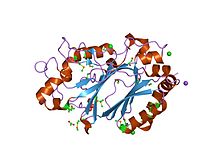- DyP-type peroxidase family
-
Dyp-type peroxidase family 
crystal structure of a dye-decolorizing peroxidase (dyp) from bacteroides thetaiotaomicron vpi-5482 at 1.6 a resolution Identifiers Symbol Dyp_perox Pfam PF04261 Pfam clan CL0032 InterPro IPR006314 Available protein structures: Pfam structures PDB RCSB PDB; PDBe PDBsum structure summary In molecular biology, the DyP-type peroxidase family is a family of haem peroxidase enzymes. Haem peroxidases were originally divided into two superfamilies, namely, the animal peroxidases and the plant peroxidases (which are subdivided into class I, II and III), which include fungal (class II) and bacterial peroxidases. The DyP (for dye de-colourising peroxidase) family constitutes a novel class of haem peroxidase. Because these enzymes were derived from fungal sources, the DyP family was thought to be structurally related to the class II secretory fungal peroxidases. However, the DyP family exhibits only low sequence similarity to classical fungal peroxidases, such as LiP and MnP, and does not contain the conserved proximal and distal histidines and an essential arginine found in other plant peroxidase superfamily members.
DyP proteins have several characteristics that distinguish them from all other peroxidases, including a particularly wide substrate specificity, a lack of homology to most other peroxidases, and the ability to function well under much lower pH conditions compared with the other plant peroxidases.[1] In terms of substrate specificity, DyP degrades the typical peroxidase substrates, but also degrades hydroxyl-free anthraquinone (many dyes are derived from anthraquinone compounds).
Crystal structures of DyP family members reveal two domains, each one adopting a ferredoxin-like fold.[2] The proteins consist of an N-terminal domain and a C-terminal domain likely to be related by a duplication of an ancestral gene, as inferred from the conserved topology of the domains. The haem iron is penta-coordinated, with the protein contributing a conserved histidine ligand to the iron centre. A conserved Asp most likely acts as a proton donor/acceptor and takes the place of the catalytic histidine used by plant peroxidases. This Asp substitution helps explain why the DyP family is active at low pH.[3]
References
- ^ Zubieta C, Krishna SS, Kapoor M, Kozbial P, McMullan D, Axelrod HL, Miller MD, Abdubek P, Ambing E, Astakhova T, Carlton D, Chiu HJ, Clayton T, Deller MC, Duan L, Elsliger MA, Feuerhelm J, Grzechnik SK, Hale J, Hampton E, Han GW, Jaroszewski L, Jin KK, Klock HE, Knuth MW, Kumar A, Marciano D, Morse AT, Nigoghossian E, Okach L, Oommachen S, Reyes R, Rife CL, Schimmel P, van den Bedem H, Weekes D, White A, Xu Q, Hodgson KO, Wooley J, Deacon AM, Godzik A, Lesley SA, Wilson IA (November 2007). "Crystal structures of two novel dye-decolorizing peroxidases reveal a beta-barrel fold with a conserved heme-binding motif". Proteins 69 (2): 223–33. doi:10.1002/prot.21550. PMID 17654545.
- ^ Zubieta C, Joseph R, Krishna SS, McMullan D, Kapoor M, Axelrod HL, Miller MD, Abdubek P, Acosta C, Astakhova T, Carlton D, Chiu HJ, Clayton T, Deller MC, Duan L, Elias Y, Elsliger MA, Feuerhelm J, Grzechnik SK, Hale J, Han GW, Jaroszewski L, Jin KK, Klock HE, Knuth MW, Kozbial P, Kumar A, Marciano D, Morse AT, Murphy KD, Nigoghossian E, Okach L, Oommachen S, Reyes R, Rife CL, Schimmel P, Trout CV, van den Bedem H, Weekes D, White A, Xu Q, Hodgson KO, Wooley J, Deacon AM, Godzik A, Lesley SA, Wilson IA (November 2007). "Identification and structural characterization of heme binding in a novel dye-decolorizing peroxidase, TyrA". Proteins 69 (2): 234–43. doi:10.1002/prot.21673. PMID 17654547.
- ^ Sugano Y, Muramatsu R, Ichiyanagi A, Sato T, Shoda M (December 2007). "DyP, a unique dye-decolorizing peroxidase, represents a novel heme peroxidase family: ASP171 replaces the distal histidine of classical peroxidases". J. Biol. Chem. 282 (50): 36652–8. doi:10.1074/jbc.M706996200. PMID 17928290.
This article includes text from the public domain Pfam and InterPro IPR006314
Categories:- Protein families
Wikimedia Foundation. 2010.
